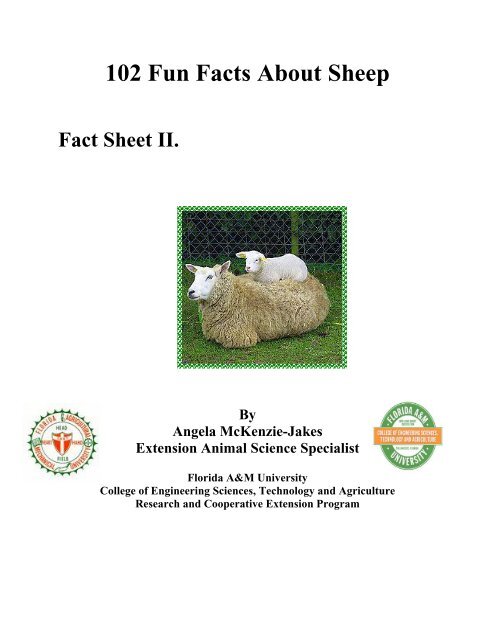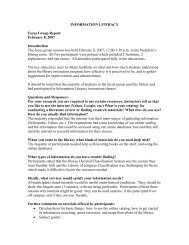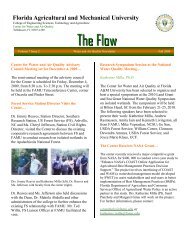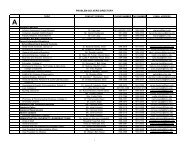102 Fun Facts About Sheep - Florida A&M University
102 Fun Facts About Sheep - Florida A&M University
102 Fun Facts About Sheep - Florida A&M University
You also want an ePaper? Increase the reach of your titles
YUMPU automatically turns print PDFs into web optimized ePapers that Google loves.
<strong>102</strong> <strong>Fun</strong> <strong>Facts</strong> <strong>About</strong> <strong>Sheep</strong><br />
Fact Sheet II.<br />
By<br />
Angela McKenzie-Jakes<br />
Extension Animal Science Specialist<br />
<strong>Florida</strong> A&M <strong>University</strong><br />
College of Engineering Sciences, Technology and Agriculture<br />
Research and Cooperative Extension Program
NO. <strong>102</strong> FACTS ABOUT SHEEP<br />
1. <strong>Sheep</strong> were domesticated 10,000 years ago in Central Asia.<br />
2. <strong>Sheep</strong> production began during biblical times.<br />
3. Raising sheep is the oldest organized industry.<br />
4. Man learned how to spin wool in 3,500 B.C.<br />
5. There are over 40 breeds of sheep in the U.S. and approximately 900<br />
different breeds around the world.<br />
6. <strong>Sheep</strong> were smuggled into the states during the 16 th and 17 centuries<br />
to develop the wool industry.<br />
7. Along with goats sheep were first brought to America by Columbus<br />
in 1493.<br />
8. The Navajo Churro is the oldest breed of sheep in the U.S.<br />
9. By 1698, America was exporting wool.<br />
10. George Washington raised sheep on his Mount Vernon Estates.<br />
11. President Woodrow Wilson grazed sheep on the White House lawn.<br />
12. The female sheep is called a “ewe.”<br />
13. The male sheep is called a “ram” or “buck.”<br />
14. A castrated male sheep is called a “wether.”<br />
15. A baby sheep is called a “lamb.”<br />
16. The act of giving birth is called “lambing.”<br />
17. The doe can have 1 to 3 lambs per litter.
18. <strong>Sheep</strong> do not have teeth in their upper front jaw.<br />
19. <strong>Sheep</strong> have 24 molars and 8 incisors.<br />
20. <strong>Sheep</strong> were first used for meat, skins, milk and wool. Today they are<br />
still raised for these purposes plus many more.<br />
21. One year’s growth of fleece is about 8 pounds of wool.<br />
22. Wool sheep are usually shorn once a year.<br />
23. Wool that comes directly from the sheep is called “raw wool.” Raw<br />
wool may go through 70 processing steps to make sure it is the<br />
highest quality.<br />
24. Depending on the market, lambs are usually sold between 90-120<br />
pounds.<br />
25. Lamb meat is an exceptional source of vitamins and minerals.<br />
26. Meat from a grown sheep is called “mutton.”<br />
27. A group of sheep is called a flock.<br />
28. Michigan has the largest sheep packing plant east of the Mississippi<br />
River.<br />
29. <strong>Sheep</strong> have a split in their upper lip which allows them to select the<br />
preferred leaves off a plant.<br />
30. In sheep, the act of breeding is called “tubing.”<br />
31. The act of parturition (giving birth) in sheep is called “lambing.”<br />
32. The weaning age of sheep is generally between 2-3 months of age.<br />
33. The pasture carrying capacity for sheep is generally 5 to 6 ewes and<br />
lambs per acre.<br />
34. An immature male ram is called a “ram lamb” and the female is<br />
referred to as a “ewe lamb.”
35. The birth weight for lambs may range from 5 to 8 pounds.<br />
36. The life expectancy for sheep is between 6 to 11 years.<br />
37. The average body temperature for sheep is <strong>102</strong>.5 F.<br />
38. The average respiration rate for sheep is 16 breaths per minute.<br />
39. <strong>Sheep</strong> generally consume 2 to 4.5 pounds of food daily.<br />
40. Depending on the breed, the mature weight for female ewes range<br />
from 90 to 300 pounds.<br />
41. Like goats, sheep are also seasonal breeders. The best time to breed<br />
is between early fall to late winter. However, there are some breeds<br />
that can be bred year-round (Dorset).<br />
42. Ewes cycle every 14-19 days during the breeding season.<br />
43. The average pulse rate for sheep is 75 heart beats per minute.<br />
44. The duration of estrus is 24 to 36 hours.<br />
45. The time of ovulation is 24-30 from the beginning of estrus.<br />
46. The gestation (pregnancy length) period for ewes is 145-155 days.<br />
47. Breeding per year is 1-2 per year.<br />
48. Depending on the breed, puberty is between 5 to 8 months of age for<br />
ewe lambs and 6 to 8 months for ram lambs.<br />
49. Depending on the breed, the minimum breeding age is between 8 to<br />
10 months for ewes lambs.<br />
50. The mature weight of a ram is between 150 to 450 lbs.<br />
51. One ram can service 30 to 35 ewes during a 60 day breeding season.
53. <strong>Sheep</strong> are born with long tails. Some producers dock their tails<br />
shortly after they are born.<br />
54. <strong>Sheep</strong> have two digits on their feet.<br />
55. <strong>Sheep</strong> milk is often used to make gourmet cheese.<br />
56. The fat (tallow) from sheep can be used to make soap and candles.<br />
57. <strong>Sheep</strong> are animals that are over one year of age.<br />
58. Lambs are less than one year of age.<br />
59. A yearling is an animal between 1 to 2 years of age that may or may<br />
not have produced offsprings.<br />
60. In some countries, sheep are used for fighting as part of a<br />
celebratory festival such as Eid al adha, a Muslim Festival Sacrifice.<br />
61. Like goats, sheep are susceptible to diseases such as parasites when<br />
they are mismanaged.<br />
62. All sheep make the sound “baa” while goats make the sound “maa.”<br />
63. Lambs can make a high pitched sound called “bleating.”<br />
64. Milk from sheep have higher levels of fat, protein, riboflavin,<br />
calcium, zinc, niacin and thiamine than milk from goats and cows.<br />
65. One pound of wool can make ten miles of yarn.<br />
66. The small intestines of 11 sheep are needed to make 1 tennis racket.<br />
67. There are 150 yards (450 feet) of wool yarn in a baseball.<br />
68. <strong>Sheep</strong> have poor eyesight, but an excellent sense of hearing.<br />
69. <strong>Sheep</strong> are considered grazers and goats are mostly browsers.
70. <strong>Sheep</strong> belong to the family Bovidae (hollowed horn), the genus Ovis<br />
and the species Ovis Aries.<br />
71. Estrus (heat) is the period in which ewes are receptive to mating.<br />
<strong>Sheep</strong> can be born with or without horns (polled).<br />
72 Normally sheep have two teats and cows have four.<br />
73. Signs of heat in ewes include rapid tail movement in the presence of<br />
the male, nervousness, walking the fence lines, increase vocalization<br />
for the ram, decrease appetite and milk production and redden and<br />
swollen vulua (not easy to detect).<br />
74. <strong>Sheep</strong> have a four chamber stomach that contains fermenting<br />
bacteria and protozoan that assist in breaking down their food.<br />
75. Rams can be quite aggressive to their handlers during the breeding<br />
season.<br />
76. <strong>Sheep</strong> are very social creatures.<br />
77. There are very few medications developed for used in sheep.<br />
78. A ruminant is any hoofed animal that digests its food in two steps.<br />
First by eating the raw materials and regurgitating a semi-digested<br />
form known as “cud” then eating the cud. Ruminants include sheep,<br />
goats, cattle, deer, camels, llamas, giraffes, bison, buffalos etc.<br />
79. The top ten states with the largest population of sheep (all sheep<br />
and lamb) are Texas (1,100,000), California (68,000), Wyoming<br />
(43,000), South Dakota (37,000), Colorado (36,000), Montana<br />
(30,000), Utah (26,500), Idaho (26,000), Iowa (25,000) and Oregon<br />
(21,500; NASS, 2005).<br />
80. Healthy lambs can stand within minutes after birth and are able to<br />
move with the herd almost immediately.<br />
81. Domestic sheep are extremly versitile and exist in a wide variety of<br />
habitats worldwide ranging from temperate mountain forests to<br />
desert conditions.
82. The skulls of domesticated sheep differ from those of wild sheep in<br />
that the eye socket and brain case are reduced. Selection for<br />
economically important traits has produced domestic sheep with or<br />
without wool, horns, and external ears. Coloration ranges from<br />
milky white to dark brown and black. There is considerable diversity<br />
among the over 200 distinct breeds of sheep.<br />
83. Copper is regularly used in the diet in sheep at about 8-11 parts per<br />
million. It may be toxic to sheep at 15-20 parts per million. There is<br />
a narrow difference between the amount of copper required and<br />
what will be toxic to the animal. A diet should never have copper<br />
level above 25 parts per million to be safe for most sheep.<br />
84. Domestic sheep are extremely hardy animals and can survive on a<br />
diet consisting of only cellulose, starch or sugars as an energy source<br />
and a nitrogen source which need not be protein. In general, sheep<br />
feed mainly on grasses while in pastures and can be fed a wide<br />
variety of hays and oats.<br />
85. The Navajo-Churro rams can have two, four, six, or more horns.<br />
This is because they possess the polycerate gene, which is also found<br />
in old heritage breeds like the Jacob <strong>Sheep</strong>. They also have the<br />
ability to have fused horns<br />
86. The Jacob sheep is a breed of primitive multihorned sheep,<br />
patterned with black and white spots. [1][2] Jacobs are grown for their<br />
wool, their meat, and their hides, but they make good pets as well. As<br />
of 2009, Jacobs are listed as threatened by the American Livestock<br />
Breeds Conservancy, which means the breed has "fewer than 1,000<br />
annual registrations in the US and estimated fewer than 5,000<br />
global population<br />
87. <strong>Sheep</strong> can be milked just like cows. <strong>Sheep</strong>s' milk is often used to<br />
make gourmet cheeses. Mutton, or the meat of sheep, is another<br />
food product for which the animals may be raised.<br />
88. The fat from sheep also known as tallow, can be used to make both<br />
candles and soap. The tallow is cooked to purify it, and then molded<br />
into candles or further prepared into blocks of soap.<br />
89 <strong>Sheep</strong> have 2 digits on each foot. The hooves grow like fingernails<br />
and need to be trimmed every few months to maintain normal<br />
conformation.<br />
90. <strong>Sheep</strong> are ruminants. This means that they have four parts to their<br />
upper digestive tract (people only have one-the stomach) and they<br />
chew their cud.<br />
91. <strong>Sheep</strong> can be set up on their rumps for restraint during procedures<br />
such as foot trimming and shearing.
92. For purpose of cleanliness, the tails are surgically shortened<br />
(docked) shortly after birth. In some parts of the world, tails are left<br />
undocked.<br />
93. Short tails are less likely to become soiled with manure and are<br />
therefore, less likely to promote local infections and fly strike<br />
94. There are many different breeds of sheep. They are classified by<br />
what kind of wool they produce. Merino and Rambouillet have fine<br />
wool. Some sheep have coarse or long wool like Cotswold, Romney,<br />
and the Barbados. But most breeds of sheep fall under the category<br />
of medium wool. Examples of sheep in this category include<br />
Columbia, Suffolk, Hampshire, Dorset, Southdown, Cheviot and<br />
Finn.<br />
95. When sheep receive a haircut, it is called shearing. The wool that is<br />
cut off is washed to get dirt, insects, and straw that may have stuck to<br />
the sheeps' fur out. The cleaned wool is then dyed to color it. The<br />
wool is combed and spun into yarn<br />
96. When Woodrow Wilson was President, the First Lady had sheep<br />
graze on the White House lawn to keep it neat and well trimmed.<br />
97. President James Madison wore an inaugural jacket made from the<br />
wool of sheep raised on his Virginia farm.<br />
98. If you see a sheep on its back, lend a hand! A sheep can’t get up from<br />
that position. If left on its back too long, it will eventually die.<br />
99. A one-year old sheep is called a hogget<br />
100. A two-year old sheep is called a two-tooth.<br />
<strong>102</strong>. <strong>Sheep</strong> only have lower teeth that press against an upper palette.<br />
References:<br />
1. Public Service of New Hampshire -<br />
http://www.psnh.com/Energy/<strong>Sheep</strong>/sheepfacts.asp<br />
2. Schoneian, S. Small Ruminant website -<br />
http://www.sheep101.info/funfacts.html<br />
3. College of Veterinary Medicine, The <strong>University</strong> of Georgia website,<br />
<strong>Fun</strong> <strong>Facts</strong> <strong>About</strong> <strong>Sheep</strong>.<br />
http://www.vet.uga.edu/vpp/animaldoc/sheep/index.php









